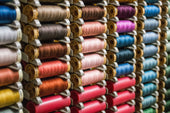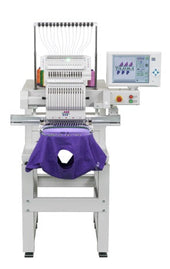Leatherwork Essentials: The Best Threads for Sewing Leather
Leatherwork is a timeless, versatile craft that opens up a world of creative possibilities. But as a beginner, it’s easy to feel overwhelmed when faced with the intricate details of a luxurious jacket or the history of an antique couch. The journey can be daunting, and unknowingly using the wrong equipment can have you second-guessing your skills. That’s where Sewingtime comes in. We’re here to break down the basics and recommend the best threads for sewing leather, so you can build confidence and master the art of leatherwork.
The Importance of Choosing the Right Thread
A common trap that beginners fall into is assuming that any thread can be used for sewing. This couldn’t be further from the truth. Best case scenario, using the wrong thread might look shabby, worst case scenario your piece could fall apart wasting hours of hard work.
The main reason we emphasise choosing the right thread is because leather goods are often subjected to wear and tear. Whether it’s a wallet that’s constantly being opened or a pair of shoes that’s hitting the pavement daily, the thread you choose needs to withstand this use without fraying or breaking.
It’s also important to remember that leather is a particularly tough material. This means it needs a thread which can glide through smoothly without causing unnecessary friction or damage. It also has to be strong enough to hold leather together securely as a weak thread will snap under pressure, ruining the integrity of your work.
In essence, the right thread makes all the difference, so take the time to choose wisely—you’ll thank yourself later when your leatherwork stands the test of time.
Types of Thread for Sewing Leather
Here’s a comprehensive exploration of the various types of threads that are perfect for sewing leather.
Waxed Polyester Thread
Waxed polyester thread is a popular choice among leatherworkers, and for good reasons:
- Strength: This type of thread is exceptionally strong, making it ideal for heavy-duty applications. Whether you're stitching a leather bag, a belt, or even a piece of furniture, waxed polyester thread can handle the stress and strain without breaking.
- Resistance to Abrasion: As mentioned before, leather items often face a lot of wear and tear. The wax coating on polyester threads enhances their resistance to abrasion, ensuring that your stitches remain intact and your project stays in excellent condition for a long time.
- Suitability for Heavy-Duty Applications: The combination of strength and abrasion resistance makes waxed polyester thread perfect for projects that require robust stitching. It’s an excellent choice for items that need to endure daily use and rough handling.
Bonded Nylon Thread
Bonded nylon thread is another top contender for leather sewing, offering several distinctive features:
- High Tensile Strength: One of the standout characteristics of bonded nylon thread is its high tensile strength. This means it can withstand significant stress and tension without snapping, making it ideal for sewing thick, tough leather.
- Flexibility: Despite its strength, bonded nylon thread is flexible. This flexibility allows it to move with the leather, preventing the stitches from becoming too rigid and potentially tearing the material.
- Resistance to UV Rays and Chemicals: Bonded nylon thread is designed to withstand exposure to UV rays and various chemicals, which is particularly useful for leather items that will be used outdoors or come into contact with different substances. This durability ensures that your leather projects maintain their integrity and appearance over time.
Other Synthetic Threads
In addition to waxed polyester and bonded nylon threads, there are other synthetic options worth considering for leather sewing:
- Polyester Threads: Regular polyester threads, even without wax, are strong and resistant to wear. They’re a versatile option suitable for a range of leather projects, from accessories to upholstery.
- Polyamide Threads: Known for their elasticity and resistance to wear, polyamide threads are another excellent choice. They offer good strength and flexibility, making them suitable for various leather applications.
Considerations When Choosing Leather Threads
If you still can’t choose, we don’t blame you. We know it’s an important decision so we’ve explored a few considerations that might help point you in the right direction.
Thickness and Weight
The thickness and weight of the thread significantly influence the strength and appearance of your stitching. Thicker threads provide greater durability, essential for items like bags or belts while also offering a bold, decorative look. Thinner threads, on the other hand, offer a subtle, refined finish ideal for delicate projects. Balancing these factors ensures a professional and polished result.
Colour Matching
Selecting a thread colour that complements your leather is crucial for achieving a cohesive and professional finish. A contrasting thread can create a striking effect, making the stitching a standout feature, while a matching thread blends seamlessly with the leather, allowing the material to take centre stage. Experimenting with different colour combinations can transform your project from ordinary to extraordinary.
Needle Compatibility
Ultimately, choosing the right needle is essential for smooth sewing and protecting your leather. The needle size should match the thread thickness—too small, and the thread may fray; too large, and it could leave unsightly holes. Leather needles, with their chisel-shaped points, are designed to penetrate leather cleanly, ensuring precise stitches. We recommend testing your needle and thread combination on a piece of scrap leather to prevent potential issues and ensure a flawless finish.
Tips for Sewing Leather with Threads
Once you’ve chosen the correct thread and are ready to start sewing, be sure to keep these three tips in mind:
- Prepare Your Leather: Start by marking your stitch lines with a ruler and awl to ensure accuracy. Use a rotary punch or stitching chisel to pierce evenly spaced holes along these lines. This preparation helps guide your stitching and ensures neat, consistent results.
- Employ the Right Techniques: For hand stitching, the saddle stitch is a popular choice, providing strength and durability. Ensure even tension to avoid puckering. If using a machine, opt for a walking foot or roller foot to handle the leather smoothly. Consistent stitch length and tension are key for a professional finish.
- Finishing Touches: Secure your stitches by backstitching at the end of each seam. Alternatively, knot the thread securely and trim the excess. For added durability, you can use adhesive tape on the seam’s underside or apply a small amount of leather glue to prevent it from unravelling.



